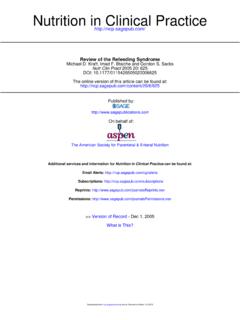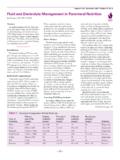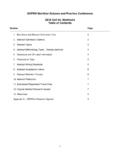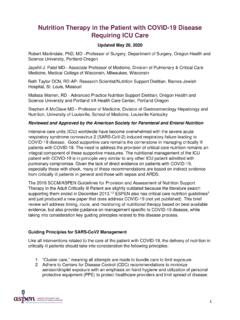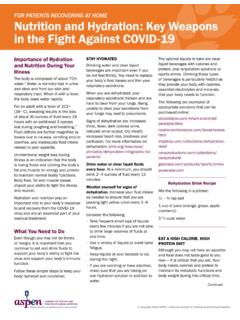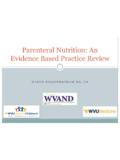Transcription of Appropriate Dosing for Parenteral Nutrition: ASPEN ...
1 Appropriate Dosing for Parenteral Nutrition: ASPEN Recommendations Persistent shortages of Parenteral nutrition (PN) components have led to a tendency of practitioners providing less than adequate Dosing , which can lead to nutrient deficiencies and impair growth and healing. Clinicians who have entered practice within the last 10 years may have never cared for patients receiving PN therapy without a shortage of PN components. This document provides both the Appropriate PN nutrient requirements and Dosing recommendations for adult, neonatal, and pediatric patients. Please share with your colleagues. Topline Recommendations Do not ration nutrients for PN if the supply of those components is sufficient to provide the full daily dose. During component shortages, follow PN management recommendations available on the ASPEN website at Return to Appropriate Dosing as soon as the component shortage has resolved.
2 Rationing and conservation strategies are intended to be used only during shortages. The lack of observed adverse events/deficiencies and the potential cost savings associated with partial Dosing should not be the impetus to continue less than optimal : These recommendations are general ranges and a patient s clinical condition and organ function should be taken into account. These recommendations do not constitute medical or other professional advice and should not be taken as such. To the extent that the information published herein may be used to assist in the care of patients, this is the result of the sole professional judgment of the attending healthcare professional whose judgment is the primary component of quality medical care. The information presented in here is not a substitute for the exercise of such judgment by the healthcare professional.
3 Circumstances in clinical settings and patient indications may require actions different from those recommended in this document and in those cases, the judgment of the treating professional should 1. MACRONUTRIENTS PNComponentDisease/Clinical ConditionProtein/Amino Acids(g/kg/d)Total Energy (kcal/kg/d)Dextrose(mg/kg/min)ILE*(g/kg/ d)Fluid (mL/kg/d)Stable ill, trauma, <4 <1 Minimal to provide adequate macronutrientsDifferent Amino Acid Requirements than AboveProtein Amino Acids(g/kg/d)Total Energy (kcal/kg/d)Traumatic brain abdomenAdditional 15-30 g/L exudateAcute kidney injury renal replacement therapyAdditional g/kg/d not to exceed g/kg/d)Chronic kidney failure with maintenance (based on dry weight and tolerance) (based on IBW)22-25 (based on IBW)IBW = ideal body weight *Soybean oil-based emulsion. For indications and Dosing of other lipid injectable emulsions (ILE), see manufacturer s product 2.
4 ELECTROLYTE AND MINERALN utrientStandard Daily RequirementFactors That Increase Needs Calcium* 10-15 mEqHigh protein intakeMagnesium8-20 mEqGI losses, medications, refeedingPhosphorus*20-40 mmolHigh dextrose intake, refeedingSodium 1-2 mEq/kg*Diarrhea, vomiting, NG suction, GI lossesPotassium1-2 mEq/kg*Diarrhea, vomiting, NG suction, GI losses, medications, refeedingAcetateAs needed to maintain acid-base balanceRenal insufficiency, metabolic acidosis, GI losses of bicarbonateChlorideAs needed to maintain acid-base balanceMetabolic alkalosis, volume depletion*Use caution in prescribing calcium and phosphorus related to = GastrointestinalASPEN Recommendations on Appropriate Parenteral Nutrition Dosing for Adult PatientsTABLE 3. DAILY REQUIREMENTS FOR ADULT Parenteral VITAMINS*VitaminStandard Daily RequirementThiamin (B1)6 mgRiboflavin (B2) mgNiacin (B3)40 mgFolic acid600 mcgPantothenic acid15 mgPyridoxine (B6)6 mgCyanocobalamin (B12)5 mcgBiotin60 mcgAscorbic acid200 mgVitamin A990 mcgVitamin D5 mcgVitamin E10 mgVitamin K150 mcg* Prescribe full daily dose unless patient able to ingest and/or absorb orally/enterally.
5 Full dose of most multivitamin products available in the US provides the above 4. DAILY REQUIREMENTS FOR ADULT Parenteral TRACE ELEMENTS*Trace ElementStandard Daily RequirementChromium <1 mgCopper mgManganese55 mcgSelenium 60-100 mcgZinc3-5 mg* Prescribe full daily dose unless patient able to ingest or absorb orally/enterally. Note: These requirements are different than the multi-trace element products currently available in the US. Copyright 2019 ASPEN | American Society for Parenteral and Enteral Nutrition 5. Dosing FOR INITIATION AND ADVANCEMENT OF PN MACRONUTRIENTSI nitiationAdvance ByGoalsInfants (<1 y)PretermTermPretermTermPretermTermProte in (g/kg/d)*1-3 (3 4 max) 3 3 3 Dextrose (mg/kg/min) 6 8 6 81 2 1 210 14 (max 14 18)10 14 (max 14 18)ILE (g/kg/d)** 1 1 13 (max g/kg/h) 3 (max g/kg/h)Children (1 10 y)Protein (g/kg/d) Dextrose (mg/kg/min)3 6 1 28 10 ILE (g/kg/d)**1 12 (g/kg/d) 2 2 Dextrose (mg/kg/min) 31 25 6 ILE (g/kg/d)**111 2*Protein does not need to be titrated; protein needs are increased with critical illness.
6 ** ILE Dosing based on soybean oil-based emulsion. See manufacturer's product information for Dosing of other ILE products. ILE= Lipid injectable emulsion GIR = glucose infusion rate; GIR calculation (mg/kg/m) = [dextrose (g/d) x 1000] / [24 (h/d) x 60 (m/hr) x weight (kg)] TABLE 6. PN ELECTROLYTE AND MINERAL DAILY Dosing *Preterm NeonatesInfants/ChildrenAdolescents & Children Greater than 50 kgSodium2-5 mEq/kg2-5 mEq/kg1-2 mEq/kgPotassium2-4 mEq/kg2-4 mEq/kg1-2 mEq/kgCalcium2-4 mEq/kg10-20 mEqPhosphorus1-2 mmol/kg10-40 mEq/kg10-30 mEqAcetate As needed to maintain acid base-balanceChloride As needed to maintain acid base-balance*Use caution in prescribing calcium and phosphorus related to Recommendations on Appropriate Parenteral Nutrition Dosing for Neonatal and Pediatric PatientsTABLE 7. PN DAILY MULTIPLE VITAMIN PRODUCT DOSINGM anufacturer Recommendations NAG-AMA Recommendations Weight (kg)Dose (mL)Weight (kg)Dose (mL)Less than than mL/kg1 to less than than or equal to 5 mLGreater than 35 Infuvite Pediatric (Baxter) and Pediatric (Hospira) Nutrition Advisory Group-American Medical AssociationTABLE 8.
7 PN TRACE ELEMENT DAILY Dosing *Trace ElementPreterm NeonatesTerm Neonates 3-10 kgChildren 10-40 kgAdolescents Greater than 40 kgZinc400 mcg/kg250 mcg/kg50 mcg/kg (max 5000 mcg/d)2-5 mgCopper20 mcg/kg20 mcg/kg20 mcg/kg (max 500 mcg/d)200-500 mcg Manganese1 mcg/kg1 mcg/kg1 mcg/kg (max 55 mcg/d)40-100 mcg/kg (max 5 mcg/d) 5-15 mcgSelenium2 mcg/kg2 mcg/kg2 mcg/kg (max 100 mcg/d)40-60 mcg*Note: These requirements are different than the multi-trace element products currently available in the US. ReferencesCorkins MR, ed. The Pediatric Nutrition Support Core Curriculum, 2nd Ed. Silver Spring, MD: ASPEN ; 2015. McClave SM, et al. Guidelines for the provision and assessment of nutrition support therapy in the adult critically ill patient: Society of Critical Care Medicine (SCCM) and American Society for Parenteral and Enteral Nutrition ( ).
8 JPEN J Parenter Enteral Nutr. 2016; 40(2):159 211. Mirtallo JM, et al. Safe Practices for Parenteral Nutrition JPEN J Parenter Enteral Nutr. 2004;28(6):S39-S70. Mueller CM, ed. The ASPEN Adult Nutrition Support Core Curriculum, 3rd Ed. Silver Spring, MD: ASPEN ; 2017. Vanek VW, et al. A call to action to bring safer Parenteral micronutrient products to the market. Nutr Clin Pract. 2015;30(4):559 569. Copyright 2019 ASPEN | American Society for Parenteral and Enteral Nutrition
